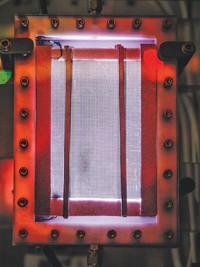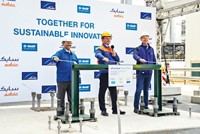Advertisement
Grab your lab coat. Let's get started
Welcome!
Welcome!
Create an account below to get 6 C&EN articles per month, receive newsletters and more - all free.
It seems this is your first time logging in online. Please enter the following information to continue.
As an ACS member you automatically get access to this site. All we need is few more details to create your reading experience.
Not you? Sign in with a different account.
Not you? Sign in with a different account.
ERROR 1
ERROR 1
ERROR 2
ERROR 2
ERROR 2
ERROR 2
ERROR 2
Password and Confirm password must match.
If you have an ACS member number, please enter it here so we can link this account to your membership. (optional)
ERROR 2
ACS values your privacy. By submitting your information, you are gaining access to C&EN and subscribing to our weekly newsletter. We use the information you provide to make your reading experience better, and we will never sell your data to third party members.
Business
Carbon Dioxide-To-Chemical Processes Poised For Commercialization
European firms seek to convert early gains into market opportunities
by Alex Scott
November 4, 2013
| A version of this story appeared in
Volume 91, Issue 44

In 1912, the Italian chemist Giacomo Luigi Ciamician published his theory that factories belching emissions from the combustion of fossil fuels one day would be replaced by smokeless processes that consume carbon dioxide. It was an intriguing idea, but one that chemists of the day likely saw as completely unnecessary.
Today, the idea of using CO2 as a feedstock—a free, abundant, and renewable feedstock—is attractive, even more so because rising levels of CO2 in the atmosphere are changing the climate. But until recently, it has been assumed that converting CO2 into useful chemicals would require too much energy to be economically viable.
Almost exactly 100 years after Ciamician made his prediction, a growing number of companies say they are on the brink of the commercial rollout of processes that use CO2 as a feedstock. With the help of catalysts that lower the energy required to activate the molecule so it will react, they are targeting the production of plastics, plasticizers, additives, fuels, and more.
“A new field is about to emerge,” Christoph Gürtler, head of Bayer MaterialScience’s catalyst program, told delegates recently at Nova-Institut’s 2nd Conference on Carbon Dioxide as Feedstock for Chemistry & Polymers in Essen, Germany.
And it is in Germany, Europe’s chemical industry powerhouse, where carbon capture and utilization is really being taken seriously, Lothar Mennicken, senior scientific officer for the German Ministry of Education & Research, told the 150 or so delegates at the meeting. German chemical firms including BASF, Bayer, and Evonik Industries expect to be among the first to commercialize CO2-to-chemical technologies.
German firms have a leg up. The German government is midway through funding a six-year, $138 million research program, dubbed FONA, through which it is encouraging academia and industry to collaborate in the development of CO2-based processes. Companies are contributing an additional $69 million to FONA. This “clearly shows industry is interested,” Mennicken said.
A Bayer process to make polyols for flexible polyurethane foam is one of the 18 projects in the CO2 program. The technology, which Bayer developed with RWTH Aachen University in Aachen, Germany, uses a zinc-based catalyst. It has been successfully tested using waste CO2 from industrial plants. Every 1 kg of polyol made saves more than 1 kg in CO2 emissions, said Niklas von der Assan, a researcher with RWTH Aachen.
Bayer has started planning a commercial facility for the technology, which it calls Dream Production. Slated for Dormagen, Germany, the plant will have a capacity of several thousand tons per year when it opens in 2015, Gürtler said.
BASF is developing CO2-based processes in several areas, including polypropylene carbonate for use in a composite material that is an alternative to acrylonitrile-butadiene-styrene. In one project, it is seeking to make acrylates from alkenes and CO2 in association with CaRLa, the Catalysis Research Laboratory at Heidelberg University. The challenge of using CO2 as an acrylate feedstock has been around for at least 30 years. Cracking the process “is the stuff that dreams are made of,” Núria Huguet, a postdoctoral researcher at CaRLa, told the audience in Essen.
Huguet is developing a catalytic process which she expects will take at least another five years before it can be rolled out commercially into what is a multi-million-ton-per-year market. But already, Huguet said, she can see “significant potential for cost reduction.”
A cohort of German firms is closing in on commercial processes that use CO2, but European Union initiatives such as SPIRE, a research program focused on public-private partnerships in the field of resource efficiency, have ignored CO2 use as a research option. “They are still thinking carbon capture and storage. We’re thinking carbon capture and utilization,” Mennicken said.
If Europe is to consolidate any lead it may have in the field of CO2-to-chemicals technology, a more structured approach and greater integration with industry are required, warned Gernot Klotz, executive director for research and innovation at the European Chemical Industry Council, an industry group. The danger is that the science will be developed independently across Europe, gaps in scientific knowledge will not be recognized, and the region will fall behind in the race to commercialize.
“Time is not on our side,” Klotz said. And he could be right. Some firms outside Europe may already be leading the race to commercialize CO2 processes. Among them is start-up LanzaTech, which was formed in New Zealand but now is based in Illinois. It expects to go commercial in the next year or two with its process to convert carbon monoxide emitted by steel factories to ethanol using engineered microbes. LanzaTech also is developing a CO2-based route to chemicals including acetic acid and 1,3-butadiene.
Unlike their German counterparts, the leading U.S. chemical firms aren’t pursuing CO2 as a feedstock. Rather, start-ups such as Waltham, Mass.-based Novomer have taken the reins. Novomer intends to start commercializing products, including a polypropylene carbonate polyol that uses CO2 as a feedstock, as early as next year, said Peter Shepard, executive vice president of polymers for the company.
Novomer’s technology converts postindustrial CO2 to CO using a solid oxide electrolysis process. A Novomer catalyst then converts the CO and ethylene oxide to acrylic acid and other chemicals.
The process not only has a CO2 footprint that is 40 to 110% smaller than petrochemical alternatives, depending on the target chemical, but it also is relatively cheap to run, Novomer claims.
Grabbing CO2 from the air, rather than using postindustrial emissions, presents a sterner challenge. A potential option is mineral carbonation, a process in which serpentinite, a mineral found in mining waste, can be used to draw CO2 from the air and bind it into a carbonate. The CO2-rich mineral can then be used as a building material by the construction industry.
“At large scale it could be done profitably,” said Michael Priestnall, founder of U.K.-based start-up Cambridge Carbon Capture. Although interest in the approach is high, more attention needs to be placed on process optimization, he acknowledged.
Looking further into the future, opportunities also exist whereby CO2 could be used in association with renewable energy and water to create energy-rich chemicals.
Michael Sterner, professor of energy systems at Germany’s Technical University of Regensburg, raised some eyebrows in Essen when he shared his vision that tanker ships could be used as the basis for generating methanol. Sterner’s idea is that sail-driven ships could be sent around oceans to drive turbines and create electricity for electrolysis that would convert CO2 and water into energy-rich materials such as methanol.
“It’s technical photosynthesis,” Sterner said. He argued that such a system could play a part in enabling the world to transition away from fossil fuels toward renewable energy.
Sterner’s methanol-generating ships may be a distant reality, but folks at Bayer, Novomer, and other firms are confident that it will be only a few years—not decades—before Ciamician’s dream of factories consuming CO2 starts to become reality.





Join the conversation
Contact the reporter
Submit a Letter to the Editor for publication
Engage with us on Twitter